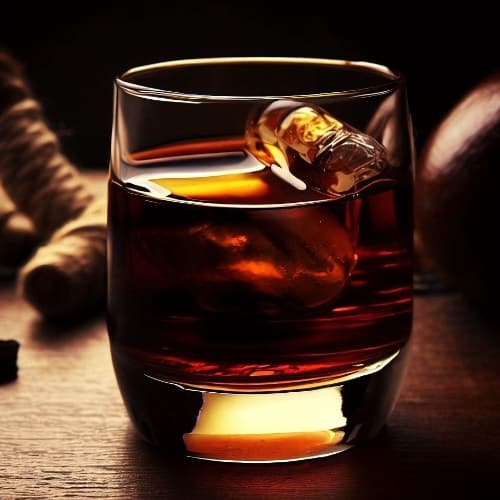Views: 3 Author: Jiateng Glass Ware Publish Time: 2023-07-26 Origin: Site











Vodka, derived from the Slavic word "voda" meaning water, is a clear and odorless spirit. It originated in Eastern Europe, with Poland and Russia being renowned for their vodka production. In fact, vodka is considered the national drink of Russia. According to the Alcohol and Tobacco Tax and Trade Bureau (TTB), vodka is defined as a neutral spirit distilled or treated after distillation with charcoal or other materials to achieve a neutral character.
Vodka is typically distilled multiple times to achieve its desired purity. It is commonly made from fermented grains like wheat, rye, corn, or potatoes. The distillation process involves heating the fermented mixture to separate alcohol from impurities. According to the Vodka Museum in Moscow, some premium vodkas go through as many as ten distillations, resulting in a smooth and refined taste.
Vodka is known for its clean and neutral taste, making it a versatile spirit for mixing cocktails. The absence of distinctive flavors allows it to blend seamlessly with other ingredients. Vodka has a relatively high alcohol content, typically ranging from 35% to 50% ABV (alcohol by volume). However, premium vodkas often aim for a smoother and more refined flavor profile. According to a study published in the Journal of Food Science, the taste of vodka can be influenced by factors such as the type of raw materials used and the distillation process.
There is a wide range of vodka brands available worldwide, each with its own unique characteristics and regional variations. Some renowned vodka brands include Absolut, Grey Goose, and Smirnoff. Russian and Polish vodkas are often associated with exceptional quality and traditional production methods. Nordic countries like Sweden and Finland are also known for their vodka production. These regional variations contribute to the diverse flavors and profiles found in different vodkas. It's worth exploring the offerings from various regions to discover your preferred vodka style.
Vodka's versatility makes it an ideal base for a wide range of cocktails. From classic favorites like the Martini and Bloody Mary to contemporary creations like the Cosmopolitan and Moscow Mule, vodka provides a neutral canvas for mixologists to work their magic. Its smoothness and ability to blend well with other flavors make it a popular choice for mixed drinks. Experiment with different vodka-based cocktails to find your perfect balance of flavors. Remember to drink responsibly and savor the unique experiences that vodka cocktails can offer.

Rum, a popular spirit with a rich history, is a distilled alcoholic beverage made from sugarcane byproducts such as molasses or sugarcane juice. It has its roots in the Caribbean, where sugarcane plantations were prevalent. According to the Caribbean Agricultural Research and Development Institute (CARDI), rum production dates back to the 17th century when European settlers began refining the process. Rum's popularity spread globally, becoming synonymous with tropical islands and exotic cocktails.
Rum can be produced through two main methods: molasses-based and sugarcane juice-based. Molasses, a byproduct of sugar production, is commonly used to make rum. It undergoes fermentation and distillation processes to create a flavorful spirit. On the other hand, some premium rums are made directly from sugarcane juice, which is freshly pressed and fermented. According to the Ministry of Rum, sugarcane juice-based rums are known for their distinct and vibrant flavors, often associated with the French agricole style.
The aging process plays a crucial role in the development of rum's flavors and complexity. Rum is often aged in oak barrels, which imparts unique characteristics to the spirit. The length of aging varies, with some rums aged for a few years while others mature for decades. According to the International Rum Expert Panel (RumXP), aging allows the flavors to mellow, and the interaction between the spirit and the wood enhances the aroma and taste profiles. Different aging techniques, such as solera or traditional cask aging, contribute to the diverse range of flavors found in aged rums.
Rum comes in a variety of styles, each offering unique characteristics and flavor profiles. Dark rum, aged for an extended period, showcases rich flavors of caramel, toffee, and molasses. Light or silver rum, with a milder taste, is versatile and commonly used in cocktails. Spiced rum, infused with spices like cinnamon and vanilla, adds warmth and complexity. Overproof rum has a higher alcohol content and delivers a potent punch. Aged rum, matured in oak barrels, develops complex flavors over time. These varieties provide a wide range of taste experiences, catering to different preferences and allowing for endless possibilities in rum cocktails and sipping neat.
Rum is a key ingredient in many beloved cocktails, showcasing its versatility and ability to create diverse flavor profiles. The classic Mojito, made with rum, mint, lime, sugar, and soda water, offers a refreshing and minty experience. The Daiquiri, with rum, lime juice, and simple syrup, delivers a perfect balance of sweet and tangy flavors. The Piña Colada, a tropical delight with rum, coconut cream, and pineapple juice, transports you to a sunny beach. These iconic rum cocktails demonstrate the wide range of possibilities and the tropical flair that rum brings to the world of mixology.
Whiskey, a beloved spirit enjoyed by many, has a rich history and diverse range of styles. It is distilled from grains, such as barley, corn, rye, or wheat, and aged in wooden barrels to develop its distinct flavors. According to the Scotch Whisky Association, whiskey's origins can be traced back to ancient times, with evidence of distillation found in different cultures worldwide. Whiskey is known for its complexity, offering a wide array of aromas and tastes. From the smoky and peaty flavors of Scotch whisky to the rich and robust character of bourbon, whiskey enthusiasts can explore various styles and regional variations. Whether sipped neat, on the rocks, or in cocktails, whiskey continues to captivate the palates of connoisseurs and casual drinkers alike.
Whiskey encompasses a wide range of styles, each with its own distinct characteristics. Scotch whisky, made primarily from malted barley in Scotland, is known for its diverse flavor profiles, ranging from light and floral to peaty and smoky.
Bourbon, a type of American whiskey, is made primarily from corn and aged in new charred oak barrels, resulting in a sweet and robust flavor.
Rye whiskey, often associated with North America, is made predominantly from rye grains, offering a spicier and drier taste.
Irish whiskey, crafted in Ireland, is typically triple-distilled for a smooth and approachable profile.
Japanese whiskey has gained international recognition for its meticulous production techniques and unique flavor profiles.
Exploring these varieties of whiskey allows for a fascinating journey through different traditions and taste experiences.
The ingredients and distillation process play a significant role in shaping the character of whiskey. The primary grain used, such as barley, corn, or rye, contributes to the whiskey's flavor profile. Malted barley is commonly used in Scotch whisky production, while corn is a prominent ingredient in bourbon. The distillation process involves heating the fermented grain mash and collecting the vapor that rises, which is then cooled and condensed to create the distilled spirit. Distillation methods, including pot stills and column stills, further influence the whiskey's characteristics. The number of distillations, the type of still, and the length of aging in oak barrels are all factors that contribute to the final flavor and complexity of the whiskey.
Whiskey production in different regions contributes to the distinct flavor profiles associated with each style. Scotch whisky, known for its regional diversity, can range from light and floral Lowland whiskies to smoky and peaty Islay expressions.
Bourbon, a uniquely American style, is characterized by its sweet and caramel notes, often with a hint of vanilla.
Rye whiskey, popular in North America, offers spicier and bolder flavors.
Irish whiskey is typically smoother and lighter, with subtle fruity and honeyed notes.
Each region brings its own traditions, climate, and aging techniques, resulting in a wide spectrum of flavors and profiles. Exploring whiskeys from different regions allows for a deeper appreciation of their unique characteristics and the influence of terroir on the final product.
Whiskey appreciation goes beyond just tasting—it involves understanding the craftsmanship and history behind each bottle. The art of nosing and sipping whiskey allows for a sensory experience, exploring the aromas, flavors, and complexities. Whiskey tasting events and distillery tours offer opportunities to learn from experts and discover new expressions.
It's important to choose the right glassware, such as a Glencairn or tulip-shaped glass, to enhance the whiskey's aromas. Whiskey enthusiasts often experiment with different food pairings to complement and contrast flavors. Whether enjoyed neat, on the rocks, or in cocktails like the Old Fashioned or Whiskey Sour, savoring whiskey is a personal journey of exploration and appreciation for the craftsmanship that goes into creating this beloved spirit.
Vodka, rum, and whiskey are three popular spirits, each with its own unique characteristics and production methods.
Vodka is a clear and neutral spirit that is typically distilled from grains or potatoes.
Rum, often associated with tropical regions, is made from sugarcane byproducts like molasses or sugarcane juice.
Whiskey is a distilled alcoholic beverage made from grains like barley, corn, rye, or wheat.
According to the Distilled Spirits Council, vodka is the most consumed spirit in the United States, followed by whiskey and rum, showcasing their widespread popularity.
Vodka, rum, and whiskey are produced using different methods and raw materials, which contribute to their distinctive characteristics.
Vodka is typically produced through multiple distillations and filtration processes to achieve its smooth and clean profile. It is primarily made from grains like wheat, rye, or corn.
Rum, on the other hand, is often distilled from sugarcane byproducts like molasses or sugarcane juice, which imparts unique flavors associated with tropical regions.
Whiskey is distilled from grains such as barley, corn, rye, or wheat, and the choice of grain and the aging process greatly influence its flavor and aroma.
The variation in production methods and raw materials is what sets these spirits apart.
Vodka is known for its neutral taste, with subtle differences depending on the raw materials used. It is often described as having a clean and crisp character.
Rum offers a wide range of flavors, from light and tropical to rich and molasses-forward, influenced by factors such as the type of sugarcane used and the aging process.
Whiskey, with its diverse styles, presents a spectrum of flavors. Scotch whisky can have notes of smoke, fruit, and spice, while bourbon is known for its sweetness and oak influence. Aging plays a crucial role in whiskey, allowing the spirits to develop complex flavors and aromas over time. The duration and type of barrels used for aging contribute to the distinct character of each whiskey variety.
Vodka, rum, and whiskey have cultural significance and regional variations. Vodka is deeply rooted in Eastern European and Russian traditions, where it is often enjoyed neat or used as a base for cocktails like the classic Moscow Mule. Rum is closely associated with Caribbean and Latin American cultures, celebrated in tropical cocktails such as the Mojito and Piña Colada.
Whiskey has strong ties to Scotland, Ireland, the United States, and other whiskey-producing regions, each offering distinct styles and production methods. Scotch whisky is renowned for its craftsmanship, while Irish whiskey is known for its smoothness. American bourbon showcases the unique flavors of corn. The cultural heritage andregional differences contribute to the diverse and rich tapestry of vodka, rum, and whiskey.
Vodka, rum, and whiskey offer endless possibilities for enjoyment and pairing. Vodka's versatility makes it a popular choice for cocktails, such as the iconic Martini or Cosmopolitan. Rum's tropical flavors lend themselves well to fruity and tropical cocktails, as well as classics like the Daiquiri. Whiskey, appreciated by connoisseurs, can be savored neat, on the rocks, or in a range of whiskey-based cocktails like the Old Fashioned or Whiskey Sour.
Pairing these spirits with food is an art in itself, with vodka complementing seafood and light appetizers, rum enhancing desserts and tropical flavors, and whiskey pairing well with rich meats and chocolate-based desserts. Exploring the world of vodka, rum, and whiskey allows for a delightful journey of flavors, traditions, and personal preferences.
In conclusion, understanding the distinctions among vodka, rum, and whiskey offers a deeper appreciation for these beloved spirits. From vodka's neutral profile to rum's tropical flavors and whiskey's diverse styles, each has its own unique character and cultural significance. Exploring their production methods, regional variations, and flavor profiles allows us to embark on a flavorful journey. Whether sipped neat, mixed in cocktails, or paired with food, vodka, rum, and whiskey continue to captivate enthusiasts worldwide. So raise a glass, toast to the craftsmanship, and savor the delightful complexities of these timeless spirits. Cheers!